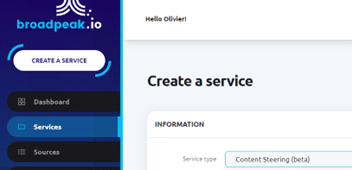Simplifying the delivery of your content through multiple CDNs
Are you delivering your content through numerous CDNs or planning to do so? Or are you looking to buy insurance in case your CDN has trouble? Well, there is a good chance that you might be interested in reading through this blog.
With the media distribution market moving at an accelerated pace to streaming, delivering traffic through multiple CDNs is becoming table stakes. Necessarily switching between multiple CDNs is becoming essential. We are preparing to introduce a new application on the platform to address this need.
Today, we are excited to allow you to be one of the first users to evaluate and test our beta Content Steering service.
We would love to hear your feedback, whether you are willing to share your comments, test this service with your own CDN and player ecosystem, or suggest a related feature.

Content Steering use cases
With streaming becoming the norm, end-user expectations have reached a demanding QoE level. Minimizing CDN delivery costs is becoming paramount, and sustainable delivery is being considered. All those requirements are related to the same type of service: the ability to switch between multiple CDNs. There are quite a few CDN selection use cases. Still, if we step back and aggregate the different scenarios, the main reasons for selecting multiple CDNs generally fall into the following categories:

Resiliency
CDN as a service, including tier ones, is subject to downtimes. Most CDN service providers, including tier ones, have experienced large-scale outages in recent years. Despite redundancy and failover mechanisms implemented by CDN service providers, the event of downtime impacting millions of users is now unthinkable. When monetizing a premium live sports program, such an event would be a lost opportunity you can never recover. From that standpoint, a multi-CDN delivery strategy is simply a must-have consideration.
QoE
CDN QoS and performances can vary over time. Throughput, error rate, latency, and TTFB (Time To First Byte) are sample KPIs that substantially impact end-user QoE (Quality of Experience). Ensuring that those metrics are always within pre-defined acceptable limits for every end user is becoming a table stake for premium content providers.
Cost optimization
Optimizing your CDN delivery costs can save you a lot of money. In several cases, decisions might be related to CDN volume commits you may have negotiated with your CDN service providers. In many cases, consuming traffic on a given CDN to meet your monthly or yearly consumption quota might be essential to staying within your negotiated $/GB price point.
Geo distribution
Some CDNs may not cover all the markets you need to address nor provide the target QoS you require for your end users. In parallel, some CDN services can provide better QoS in some regions but perform poorly in others. Assigning specific CDN delivery services for particular markets, regions, or AS can be practical.
Sustainability
Beyond QoE and cost criteria, sustainable CDN resources are gaining traction to meet sustainability targets. Some organizations, such as Greening of Streaming, are helping the industry normalize those considerations. In the future, we believe this requirement will have a more substantial weight and help discriminate between the different CDN providers.
What is Content Steering?
Now that we’ve looked at the use cases, we might want to connect the dots with the technology.
Content Steering describes a deterministic way of delivering content to streaming players. It is based on a specification defined for Apple HLS and the DASH standard.

One of the most critical problems Content Steering solves is non-deterministic player behavior. As players usually implement their retry, failover, QoS, or buffer optimization strategies, behaviors vary widely from one vendor to another. Content Steering is defining how players should select the streaming CDN. However, it is an open-ended protocol as it does not explain how traffic should be steered and distributed. Those considerations are usually part of the business logic layer, which sits on top and defines the rules and policies for CDN delivery.
Regardless, Content Steering option offers an attractive approach for the following reasons:
- It has been explicitly designed for CDN selection
- It leaves the door open to separate external components (e.g. business rules and policies)
- It is standard-based (open and public specification)
- Apple and DASH-IF are aligned to ensure consistent behaviors for HLS and DASH
- It is gaining traction within the industry
Content Steering in action
Our next blog will explore content steering using our beta application and showcase how the service works in different cases.

This is an opportunity for you to steer (not just content but also) our application in the direction you need. Let us know, and we’ll give you access to our beta. Feel free to email us at contact@broadpeak.io or send us a few words in the chat prompt.










